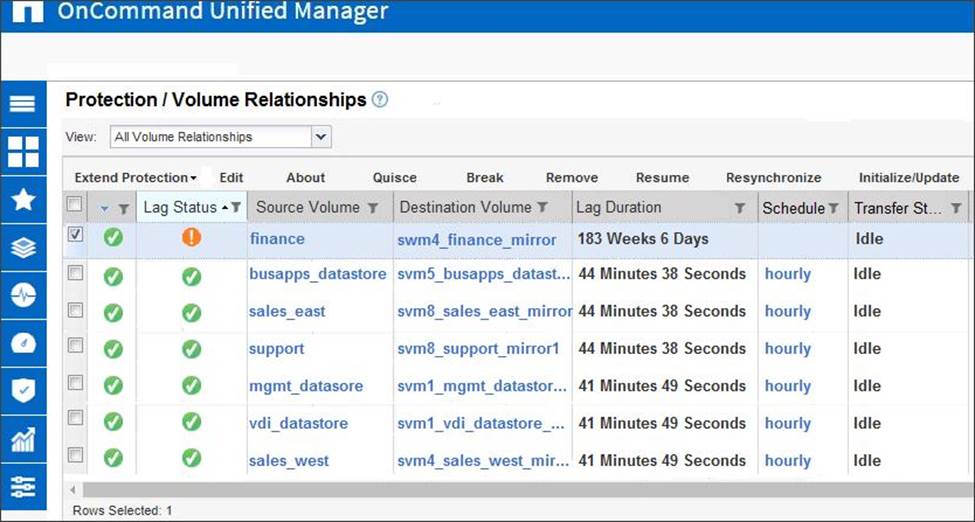Network Appliance NS0-526 NetApp Certified Implementation Engineer, Data Protection Online Training
Network Appliance NS0-526 Online Training
The questions for NS0-526 were last updated at Dec 15,2025.
- Exam Code: NS0-526
- Exam Name: NetApp Certified Implementation Engineer, Data Protection
- Certification Provider: Network Appliance
- Latest update: Dec 15,2025
You are asked to implement a DR solution to protect employee home directories on the primary cluster. The solution should provide an PRO of one hour, disaster recovery and archiving configured on the same destination volume of the DR cluster. Your solution should also reduce the amount of secondary storage requirements and use lower network traffic on the WAN links.
In this scenario, which NetApp replication technology satisfies these requirements?
- A . SnapMirror-Sync
- B . SyncMirror
- C . MetroCluster
- D . SnapMirror
An administrator notices that a NAS volume has been filled completely by active data and Snapshot copies that have expanded over the Snap reserve. The volume is no longer writable.
In this scenario, which two actions must you take to make the volume writable again? (Choose two.)
- A . Delete Snapshot copies until space is available.
- B . Delete the files in the active file system.
- C . Delete the SnapMirror relationships.
- D . Delete the SnapVault relationships.
You have two ONTAP clusters, cluster1 and cluster2. Cluster1 has an SVM serving SMB3 data and you want to protect it by replicating it to cluster2 using SVM DR. The source and destination subnets are identical. You want to retain the CIFS server security of the SVM at the destination site.
In this scenario, which three steps would you take to configure the SVM DR relationship? (Choose three.)
- A . Configure the network for data access on the destination SVM.
- B . Create the SnapMirror relationship with the id-preserve option set to true.
- C . Create the destination SVM with the dp-destination subtype.
- D . Create a CIFS server on the destination SVM.
- E . Initialize the SnapMirror relationship.
Click the Exhibit button.

You have been receiving the lag status error notifications shown in the exhibit.
What must you do to correct this problem?
- A . Resynchronize the relationship.
- B . Add a schedule to the relationship.
- C . Fan out the relationship.
- D . Quiesce the relationship.
You are working for a customer that has deployed a large FlexGroup with ONTAP 9.5. This FlexGroup has a SnapMirror relationship to a system at a disaster recovery site. The FlexGroup is nearly full and needs to be expanded to accommodate additional data.
In this scenario, what must you do to expand the FlexGroup and ensure that the data remains protected?
- A . Break the SnapMirror relationship, expand the source FlexGroup, and update the SnapMirror.
- B . Offline the source FlexGroup, add additional volumes, bring it online, and update the SnapMirror.
- C . Expand the source FlexGroup nondisruptively, and update the SnapMirror.
- D . Break the SnapMirror relationship, expand the source FlexGroup, and re-baseline the SnapMirror.
Which two cloud providers allow you to provision Cloud Volumes ONTAP as a SnapMirror destination? (Choose two.)
- A . Azure
- B . DigitalOcean
- C . AWS
- D . RackSpace
A customer wants to enforce prompt tiering when the cooling threshold has been reached.
They want to do this even though the data may have been deleted or the data continues to exist in the primary file system.
In this scenario, which tiering policy should be used?
- A . Auto
- B . Snapshot-only
- C . Backup
- D . None
A customer wants to assign a user to a build-in SnapCenter RBAC Role that will allow them to review and start existing SnapMirror processes only.
In this scenario, which Role will allow the customer to accomplish this task?
- A . App Backup and Clone Admin
- B . Infrastructure Admin
- C . Backup and Clone Viewer
- D . SnapCenter Admin
You have deployed volume-level replication with NetApp Synchronous SnapMirror replication technology.
In this scenario, which two statements are true? (Choose two.)
- A . In Sync mode, the application I/O fails if the write to the secondary storage is not completed, thereby ensuring that the primary and secondary storage are identical.
- B . In StrictSync mode, the application is allowed to continue writing to the primary storage
if the write to the secondary storage is not completed. - C . In Sync mode, the application is allowed to continue writing to the primary storage if the write to the secondary storage is not completed.
- D . In StrictSync mode, the application I/O fails if the write to the secondary storage is not completed, thereby ensuring that the primary and secondary storage are identical.
Click the Exhibit button.

A client has a SnapMirror relationship between two sites that is scheduled to run once a day at 12:15 a.m. They have a network connection between two sites that provides 100 Mbps on bandwidth. By performing the backup at this time, they can maximize their bandwidth use.
Referring to the exhibit, how long does the SnapMirror update take to finish?
- A . one hour
- B . four hours
- C . three hours
- D . two hours
Latest NS0-526 Dumps Valid Version with 212 Q&As
Latest And Valid Q&A | Instant Download | Once Fail, Full Refund

